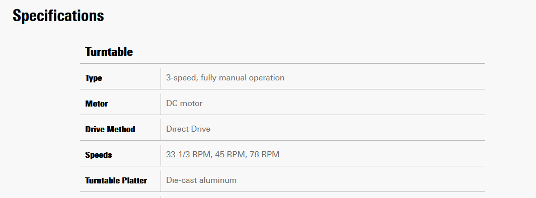Understanding your turntable's product specifications

You have decided to purchase a turntable and have spent a good deal of time on the product page of several turntables to work out which is the best one for you. The problem is that you are new to vinyl records and have no idea what wow and flutter, maximum tracking error angle, and a whole host of other specifications and terms mean. Don't worry, this article covers some common specs and what they mean. Please note that these definitions are simplified for ease of understanding for those with little turntable knowledge.
Turntable Specs
Type – This refers to both the speed capabilities (33-1/3, 45 and 78 RPM) and the operation of the turntable’s tonearm. Common types are manual, semi-automatic, and fully automatic.
Motor – Indicates whether the motor is powered by AC or DC.
Drive Method – This is the method used to turn the platter. A direct drive has the platter connected directly to the motor. A belt-drive turntable has the platter connected to the motor by a drive belt. A less common method is the idler arm where the platter is turned by a rubber idler wheel.
Speeds – Indicates the number of revolutions per minute (RPM) at which the turntable can operate: 33-1/3, 45 or 78 RPM. Of course, you will need the speeds that correspond with the records in your collection. Most turntables will operate at 33-1/3 and 45 RPM. Some turntables will operate at all three speeds, and others can be sped up and slowed down via a pitch control. The latter are commonly used as DJ turntables.
Platter – This generally identifies the material the platter is made of, such as die-cast aluminum or polyoxymethylene.
Plinth – This is the base or foundation that the turntable is made from, which supports all of the components. Made from such materials as wood or MDF (medium density fiberboard).
Torque – Refers to the turning power of the platter. This is very much dependent upon the strength of the motor.
Wow and Flutter – Wow describes slow variations in pitch. Flutter describes rapid variations in pitch. This is measured as a percentage, with low numbers indicating better performance.
Rumble – This is the noise that is generated by all the moving parts integral to the turntable and picked up by the stylus. This spec is not usually listed.
Signal-to-Noise Ratio – The signal-to-noise ratio, also designated as SNR or S/N, is a measure that compares the level of a desired signal to the level of background noise. The signal-to-noise ratio is defined as the ratio of signal power to the noise power. This is usually expressed in decibels.
Tonearm Specs
Type – This is the shape of the tonearm, such as straight, S-shaped or J-shaped.
Effective Length – This is the length, measured in a straight line, from the tonearm pivot point to the tip of the stylus.
Effective Tonearm Mass – The effective mass is the mass of the tonearm, including the headshell, exerted on the stylus. A mass of 10 grams or lower is considered a low-mass arm. A mass of 11-25 grams is considered moderate mass. An arm rated at above 25 grams is considered high-mass. This is important when considering what cartridge to purchase.
Overhang – This is the amount by which the stylus overhangs the spindle when the tonearm is placed directly over the spindle.
Maximum Tracking Error Angle – The tracking angle is measured from the pivot point of the cantilever to where the stylus makes contact with the record. This assumes that the tonearm and headshell are level (with no shims) and the proper tracking force is set. The proper angle is specified by the cartridge manufacturer and is commonly 20 degrees. The maximum tracking error angle indicates how much this can be deviated from.
Stylus Pressure Adjustment Range – The tracking force, also known as stylus pressure, is the weight at which the stylus should set on the record. Most often this this can be set within a range of weights. For example, the cartridge manufacturer may recommend a weight somewhere between 1.5 grams and 2.5 grams.
Applicable Cartridge Weight Range – This is the recommended cartridge weight range that a particular tonearm’s supplied counterweight can counterbalance with the provided headshell. It is important to note whether the specification includes the weight of the headshell or not. If using a cartridge + headshell that is too heavy, the proper tracking force cannot be set.
If you have further questions about turntables or any Audio-Technica product, please contact us.